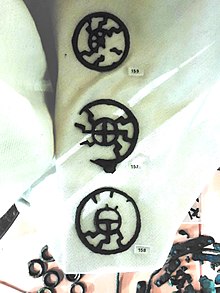Decorative disk
Ornamental disk refers to thin, disk-shaped pendants in archeology , with a presumably apotropaic function, which were widespread in Central Europe from antiquity to the Merovingian period .
Ornamental discs were from the early Bronze Age around 800 BC. Widespread in Europe until the Iron Age . Ornamental washers were most widespread in Alemannic , Franconian and Bavarian women's fashion. With the increasing Christianization of the early medieval population, the decorative discs gradually disappeared almost completely from the women's costume. The decorative discs were mostly made of bronze , more rarely iron and even more rarely silver or gold . They were mostly openwork and provided with elaborate hallmarks . During the period of their use, decorative discs experienced very characteristic and changeable fashionable designs. Many decorative disks showed abstract, geometric patterns in a symmetrical division. Some showed animal representations in animal style I such as snakes or bird heads arranged as a triskel or quatrefoil . A small group of decorative disks showed two people with their limbs intertwined, or simple equestrian images with horses. In addition to the purely decorative character, archaeologists, historians and folklorists ascribe an amulet function to the decorative discs . Ornamental discs were worn individually by women on a belt hanger , on a ribbon that hung from the wearer's belt and to which a whole series of other amulets or implements could be attached. Archeology does not yet agree on the exact way of carrying. Particularly in the case of large decorative disks, in connection with a surrounding bone, wooden or metal ring, it was assumed that they formed the closure of a bag-shaped pocket. The evaluation of current archaeological finds will in future give a more precise picture of the way of carrying.
supporting documents
- ^ Emil Vogt: Interpretation and museum evaluation of Alemannic grave finds.
literature
- Dorothee Renner: The openwork decorative panels from the Merovingian era. Roman-Germanic Central Museum, Mainz 1970 (dissertation).
- Emil Vogt: Interpretation and museum evaluation of Alemannic grave finds. In: Journal for Swiss Archeology and Art History. 20, Zurich 1960.
- Hermann Ament : Ornamental washer. In: Reallexikon der Germanischen Altertumskunde (RGA). 2nd Edition. Volume 34, Walter de Gruyter, Berlin / New York 2007, ISBN 978-3-11-018389-4 , pp. 535-537.

